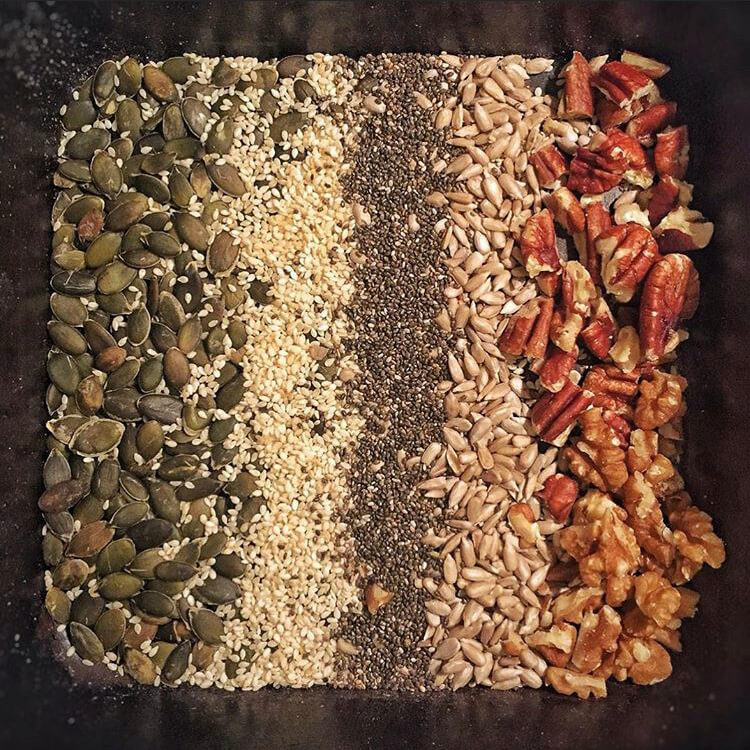You know how health blogs always harp on about the benefits of nuts and seeds? Well this one is no exception. Indeed, plenty of nutritional studies (including rigorous interventional trials) have found that regular consumption of nuts and seeds significantly reduces the risk of lifestyle diseases and premature death overall. And despite their high calorie-density, they are causally linked to weight loss (crazy, right?). Walnuts, in particular, come out tops: they’re the highest in antioxidants and omega-3 fatty acids, and they’ve specifically been shown to suppress cancer growth.
In general, nuts and seeds are highly satiating. In other words, you’ll feel fuller for longer, and you’re less likely to eat other (less nutritious) foods later on. Sneak a small handful into your meals, e.g. into a smoothie for extra protein, sprinkled over a salad, or mixed into your overnight oats.
By the way—some fun (but not at all important) botanical facts about nuts:
- Chestnuts and hazelnuts are ‘true nuts’, botanically speaking (with a hard outer shell enclosing both the fruit and the seed);
- Almonds, walnuts and cashews are drupes (a seed inside a hard stone inside a fleshy fruit);
- Peanuts are technically legumes (or rather, the seeds of legumes);
- Beans—you guessed it—are also seeds!
What do all these have in common? I’m sure you’ve connected the dots by now… they’re all seeds! (Why we call them nuts is probably some etymological quirk, e.g. a nut is also a small lump of something hard, or the Dutch word for ‘useful’.) On to a more pertinent topic…
Why should we be eating seeds?
Or, why are they so nutritious?
Think about it from the plant’s perspective. Seeds have all that they need to germinate and grow into a little plant, given the right environmental conditions: moisture, oxygen and warmth. They literally contain the food needed to fuel the plant’s growth—they are pretty much the definition of nutrient density, with a rich store of protein, oils and starches.
Clearly, based on an abundance of scientific evidence, we need to be eating them if we’re going to up our health game. So I thought I’d share a nifty list of nuts and seeds that you might find at a supplier near you, along with one meal idea for each. It’s a good idea to prioritise seeds with a high concentration of Omega-3 fatty acids (such as walnuts, flax seeds, chia seeds and hemp seeds), but in addition to that, just enjoy whatever you can find (and afford) locally.
- almonds: almond butter
- brazil nuts: muesli with nuts & dried fruit
- cashews: cashew cream cheese
- chestnuts: roasted chestnut soup
- chia seeds: chia pudding
- flax seeds: mixed seed crackers
- hazelnuts: vegan ‘nutella’
- hemp seeds: smoothie protein boost
- macadamia nuts: macadamia ‘cheese’
- mustard seeds: homemade wholegrain mustard
- peanuts: peanut stew
- pecan nuts: roast sweet potato, baby spinach & pecan salad
- pine nuts: vegan ‘parmesan’ mix
- pistachios: pistachio chocolate fudge
- pomegranate seeds: avocado, quinoa & pomegranate salad
- poppy seeds: lemon poppy seed cake
- pumpkin seeds: roasted & spiced pumpkin seeds
- sesame seeds: tahini
- sunflower seeds: sunflower alfredo pasta
- walnuts: lentil walnut ‘meatballs’
There are a lot of fancy recipes out there in the inter webs and these are just some ideas. But if you’re like me, and 90% of the time you just want food to be fast and easy, don’t worry about recipes. A lot of nuts and seeds can be eaten raw—or just pop them into the oven to toast them up, or blend them into whatever else you’re making for added creaminess or a protein boost.
(Just bear in mind that some seeds, like flax, have a protective hull or shell, so they need to be soaked, roasted or ground up before our bodies can digest them.)
Hope this was useful! I’m off to eat a handful of toasted pumpkin & sunflower seeds 🙂


Comments
Pingback: How to make your own nut butter - Plantiful Coach